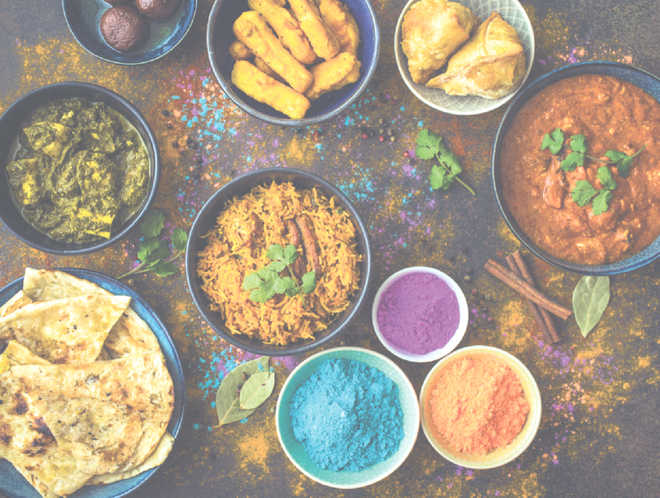
iStock
Pushpesh Pant
As Holi approaches, our thoughts turn to colours of food. We have always wondered as to why the traditional foods made on a day dedicated to absolute fun eschew colour. Don’t get us wrong. We love our gujiya — the crescent shaped Indian pastry packed with mawa, enriched with raisins and nuts and lovingly deep fried over very low heat — and the glass of thandai that an American friend of ours would call the almond grass drink during the hippie era. To confess something, we prefer our thandai without any grass, and in that we digress again.
Perhaps, it is the surfeit of colours on this day that makes the delicacies so humble. Clouds of abeer and gulaal billow and bands of no-holds-barred revellers prowl on the streets, drenching one and all with coloured water. After the fun and games are over, there is little energy left to cook an elaborate multi-dish meal. Most families are content to eat a light but satisfying kadhi-chawal lunch, followed by a well-earned siesta — to sleep and perchance to dream, of colourful food, maybe!
With the growing awareness regarding hazards of chemical Holi colours, more and more people have started substituting these with non-toxic organic colours. The same health consciousness is alerting people to read labels on packaged food. Synthetic colours are no longer attractive. The brighter the tint, the greater the alarm. ‘Nature identical’ is not the same as ‘natural’, be it flavours or colours. At the same time, it can’t be denied that colours enhance the joy of eating manifold. What then is the way to find bliss at the end of the rainbow?
We recollect a memorable meal that we were served by a host who has roots in Lucknow. The multi-course Holi lunch dazzled with almost all the colours from a painter’s palette. Best of all, no food colours were used. The magic was created using ingredients such as beetroot, carrots, spinach, tomatoes, turmeric, red chillies, brinjals... All contributed a distinct tint along with taste. Great care was taken to ensure that the colours don’t bleed. Of course, there was sheesh ranga pulao to show off the superlative skill of displaying six colours in one dish but the real charm of this specially curated meal lay in its polychromatic composition synchronised with flavours. Different shades of primary colours were on display as well as the ‘black and blue’ seldom encountered on a dinner plate. Kali gajar ka halwa vied with habshi halwa to assert that ‘black is beautiful’! Steaming white rice and bowls of thick dahi helped the coloured dishes stand out.
Now, we had not realised that cuisines outside of Awadh could also boast of an equally colourful culinary repertoire until our friend Aditya Mehendele from Pune opened our eyes to the myriad colours of Kolhapuri mutton rassa — from scarlet, to yellow, green and black. The delicate violet of the sol kadi was not only soothing to the eyes, but also brought relief to our scorched palate!
Another inspired hostess from Kashmir took up the challenge to match colour for colour in any regional menu. She exerted to replicate the hues of rassa with chaaman (except the black one!) and turned out a scarlet al ka roganjosh as well. It was hard to lay your hands on kaangucchi that cast its dark spell.
Hope to be invited for more such rainbow luncheons.
Gujiya
Ingredients
- 1 cup flour (rava and whole wheat)
- 250 g mawa
- 1/2 cup coconut (grated)
- 1 cup dried fruits and nuts (chironji, pistachios and raisins)
- 1 tsp green cardamom seeds
- Sugar to taste
- Oil to deep fry
Method:
- Prepare a soft dough mixing water or milk with flour. Then let it stand for 30 minutes. Now roll out discs about 5 inches in diametre on a flat surface.
- In the meantime, get the stuffing ready by dry roasting the mawa (till it is light brown) and mixing it with nuts and raisins along with cardamom seeds. Place a portion of this in the middle and cover by flipping over the other side. Press the edges firmly after lightly moistening your fingers to seal properly. Continue till all the material is used up. Heat oil and reduce the flame to medium-low. Fry gujiya in batches till they are light golden and blistered on the outside. Remove with a slotted spoon and drain the excess oil on kitchen towels. For best results, deep fry the gujiya on low heat without losing patience.
Thandai
Ingredients
- 2 litres full fat milk
- 1/2 cup almonds (soaked overnight and skin removed )
- 1 tbsp magaz
- 1 tsp poppy seeds
- 1 tsp fennel seeds
- 1/2 tsp black peppercorns
- 1/2 tsp green cardamom seeds
- A few strands of saffron (soaked in rose water or lukewarm milk)
- 1/4 cup sultanas (seeded)
- Rose petals for garnishing
Method:
Boil milk in a heavy, thick bottomed vessel over low heat. Stir constantly till it is reduced to almost 1/4 its original volume. Grind all the other ingredients to a smooth paste. When the milk cools down, add the paste to it. Stir well. Pass it through a muslin cloth, if desired. Serve chilled after adding a little water if you prefer thinner consistency.



























